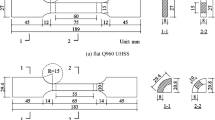Abstract
Fire resistance steel maintains strength at high temperatures and its allowable temperature is higher when compared with generic steel. Thus, it is needed to analyze its fire resistance quantitatively. In this study, high temperature creep tests of fire resistance steel specimens were conducted with variables of stress ratio and temperature to analyze their mechanical properties and behavior at a fire. The creep limit temperature of the Steel New (SN) steels observed from the high temperature tests was below 538 °C. The FR (Fire Resistance) steels showed stable creep behavior until 600 °C and maintained lower level of deformation for a longer period of time when compared with what was observed from previous studies. It is deduced that the FR steels are very effective in resisting deformation at high temperatures. As stress ratio increased, strain increased almost tenfold. Since strain increased very rapidly approximately from 1%, it is required not only to compare difference in final strain but also to quantitatively analyze creep behavior when strain is 0.5–1% and build up critical deformation data.








Similar content being viewed by others
References
Anderberg, Y. (1976). Fire-exposed hyperstatic concrete structures—an experimental and theorical study, Div of Struct Mech and Concrete Constr, Inst. of Tech, Lund.
ASTM E21. (2009). Standard test methods for elevated temperature tension tests of metallic materials. ASTM E21, ASTM—ASTM International 8.
Azhari, F., Heidarpour, A., Zhao, X.-L., & Hutchinson, C. R. (2017). Effect of creep strain on mechanical behaviour of ultra-high strength (Grade 1200) steel subject to cooling phase of a fire. Construction and Building Materials, 136, 18–30.
Basirat, M., Shrestha, T., Barannyk, L. L., Potirniche, G. P., & Charit, I. (2015). A creep damage model for high-temperature deformation and failure of 9Cr-1Mo steel weldments. Journal of Metals, 5, 1487–1506.
British Standard Institution. (2003). Structural use of steelwork in building. In: Part 8: Code of practice for fire resistant design. London.
Cowan, M., & Khandelwal, K. (2014). Modeling of high temperature creep in ASTM A992 structural steels. Engineering Structures, 80, 426–434.
Guguloth, K., & Roy, N. (2017). Creep deformation behavior of 9Cr1MoVNb (ASME Grade 91) steel. Materials Science and Engineering A, 680, 388–404.
Harmathy, T. Z. (1967). Comprehensive creep model, National Research Council of Canada. Journal of Basic Engineering Series D, 89(3), 496–502.
Kim, J.-S. (1989). Characteristic of fire resistance steel for building structure. Journal of Korean Society of Steel Construction KSSC, 12(2), 18–25. (in Korean).
KS B 0801. (2007). Test pieces for tensile test for metallic materials. Korea Agency for Technology and Standards (in Korean).
KS B 0814 (2001). Tensile creep test method of metallic materials. Korea Agency for Technology and Standards (in Korean).
KS B 5536 (2002). Creep tester for metal materials. Korea Agency for Technology and Standards (in Korean).
KS D 3865 (2016). Fire resistance steels for architectural structures. Korea Agency for Technology and Standards (in Korean).
Kwon, I. K. (2007). Evaluation on the mechanical properties of fire resistant steels at high temperature conditions with manufacturing processes. Journal of Korean Society of Steel Construction, 19(2), 181–190. (in Korean).
Maraveas, C., & Fasoulakis, Z. (2014). Post fire mechanical properties of structural steel. In: 8th National steel structures conference, Tripoli, Greece.
Matsui, C., Tsuda, K., Yamaji, Y., & Fujinaga, T. (1998). Structural performance and axial load limit of concrete filled steel square tubular columns. Journal Structures Constructions Engineering AIJ, 504, 103–110.
Outinen, J., & Makelanen, P. (2004). Mechanical properties of structural steel at elevated temperatures and after cooling down. Fire and Materials, 28, 237–251.
Park, D.-B., Hong, S.-M., Leea, K.-H., Huh, M.-Y., Suh, J.-Y., Lee, S.-C., & Jung, W.-S. (2014). High-temperature creep behavior and micro structural evolution of an 8Cr9Ni3CuNbVN austenitic stainless steel. Materials Characterization, 93, 52–61.
Poh, K. W., & Bennetts, I. D. (1995). Analysis of structural members under elevated temperature conditions. Journal of Structural Engineering, 121(4), 664–675.
Ramirez, J., Potirniche, G. P., Pugesek, H., Shaber, N., Taylor, M, Stephens, R., & Charit, I. (2018). Predicting creep-fatigue crack growth rates in Alloy 709 using finite element simulations of plasticity and creep-induced crack closure. In MATEC Web of Conferences (Vol. 165), 12th International Fatigue Congress, FATIGUE 2018.
Srpcic, J., & Houska, M. (1995). Creep factors for wood and glulam structures. In Proceedings of the 1990 International Timber Engineering Conference (pp. 416–423). Tokyo, Japan.
Funding
This work was supported by the National Research Foundation of Korea (NRF) grant funded by the Korea government (MSIT), No. 2021R1A4A1031201.
Author information
Authors and Affiliations
Corresponding author
Additional information
Publisher's Note
Springer Nature remains neutral with regard to jurisdictional claims in published maps and institutional affiliations.
Rights and permissions
Springer Nature or its licensor (e.g. a society or other partner) holds exclusive rights to this article under a publishing agreement with the author(s) or other rightsholder(s); author self-archiving of the accepted manuscript version of this article is solely governed by the terms of such publishing agreement and applicable law.
About this article
Cite this article
Kim, SH., Choi, SM. Creep Characteristics and Behavior of Fire Resistance Steel (FR355B) Exposed to High Temperatures. Int J Steel Struct 23, 1202–1210 (2023). https://doi.org/10.1007/s13296-023-00759-7
Received:
Accepted:
Published:
Issue Date:
DOI: https://doi.org/10.1007/s13296-023-00759-7




